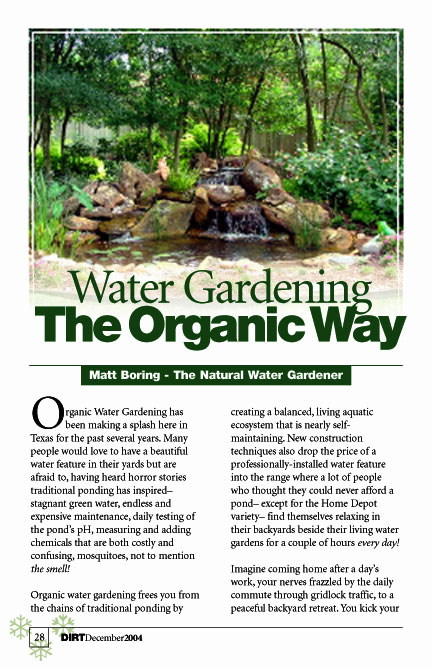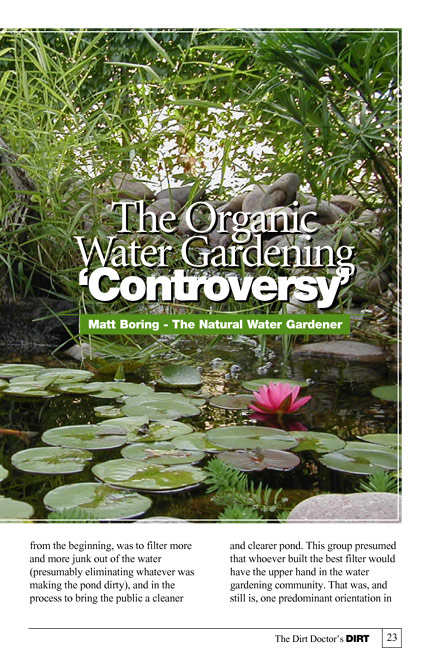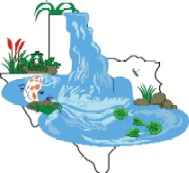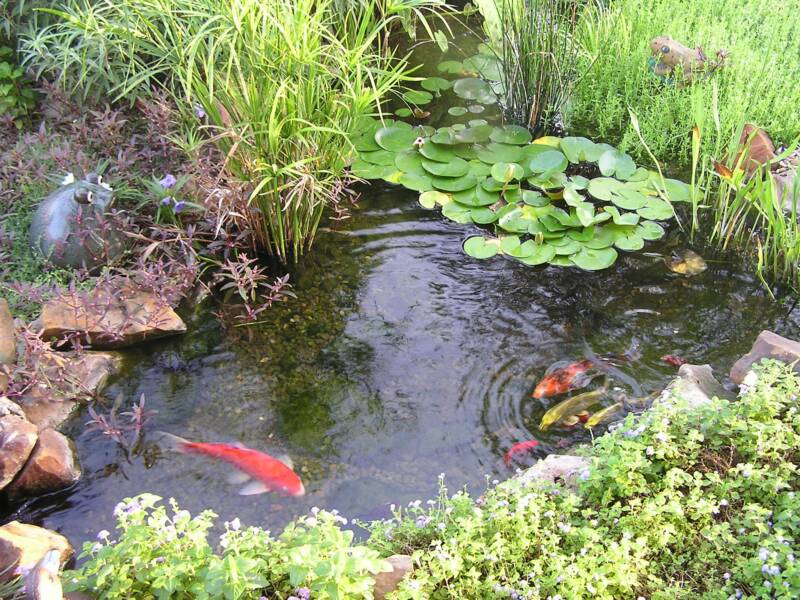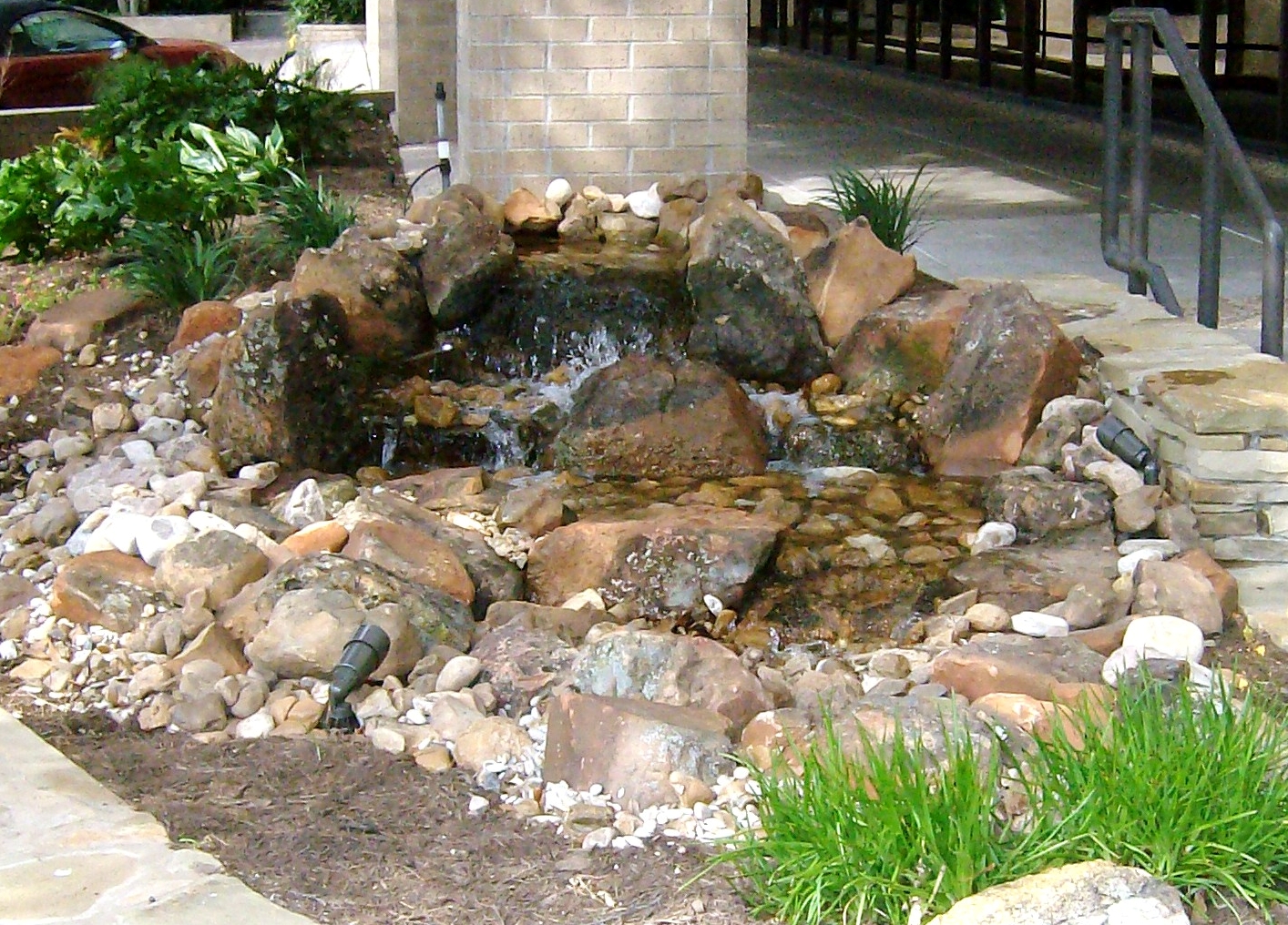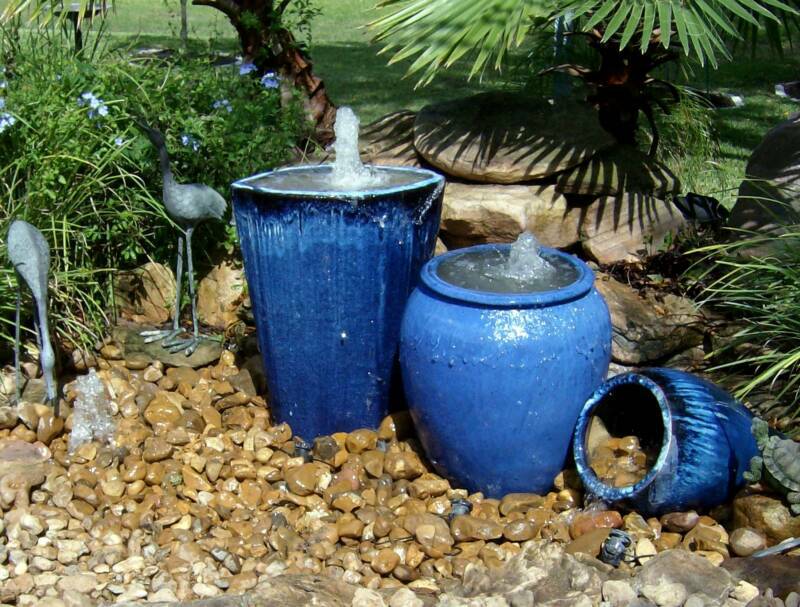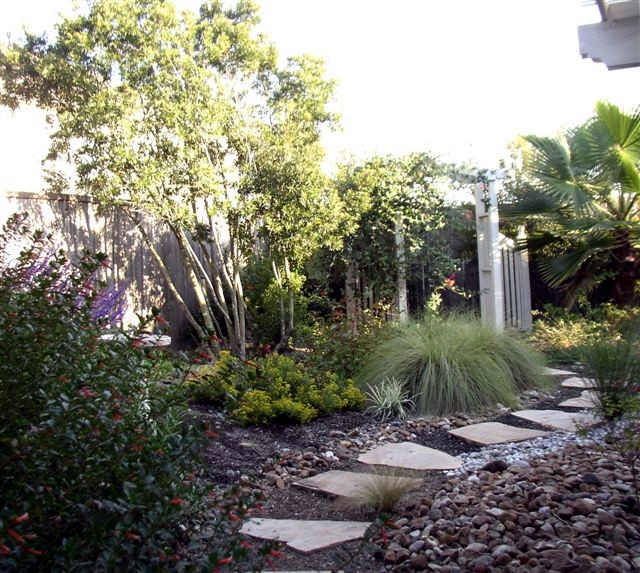Texas Ponds and Water Features
Austin 512-782-8315 281-668-4077 Houston


Rainwater Harvesting
Organic Ecosystem Ponds
Pondless Waterfalls
Urn and Fountain Features
Water-Wise Landscapes
Choosing Plants for Your Pond
by Matt Boring
the Natural Water Gardener
Plants are one of the main parts of your water garden that really make it come alive. They put the ‘scape’ in your waterscape. If you’re a novice water gardener, don’t let the plants scare you at all. They’re easy to plant, easy to take care of, and best of all, never need watering or fertilizer! Aquatic plants come in an endless variety of heights, colors, and textures. Different plants grow from different depths in your pond, so it truly becomes a three-dimensional garden. That’s another good reason I construct my ponds with several levels.
The plants also serve an important part of the balanced ecosystem of your pond. You see, the ammonia in fish waste is converted by the bacteria and enzymes in the biological filter to ammonium nitrate, which is natural plant fertilizer. It’s not as toxic to the fish, but it still needs to be gotten out of there or it will cause an algae bloom. You see this happening in natural and farm ponds a couple of times a year. That’s where the plants come in. Most of the plants in the water garden are planted directly into the gravel substrate of the ecosystem pond. Their roots are allowed to grow unconstrained by pots. The plants will perform better for you this way, but more importantly, their roots will spread out into a giant natural filter, becoming a magnet for the free floating nutrients in your pond water. The less nutrients available in the water, the less chance you have for out-of-control algae that makes your water the color of pea-soup or forms large strings across the pond. The key is to achieve a natural balance between the plants, fish, and beneficial bacteria in the ecosystem.
A word of warning, though. There are some plants that are extremely aggressive in some parts of the state because it doesn’t get cold enough to freeze them back sufficiently in the winter time. They will soon take over an average sized back yard water garden and you’ll soon have more garden than water. Avoid letting giant pennywort, water celery, and water lotus out of their pots or you’ll be sorry. I’d recommend avoiding the giant pennywort altogether. By all means, don’t avoid the water lotus, though. Place it in the pond and disguise the pot with rocks or stick a decorative pot down into the pond and place the plastic pot with the water lotus into that pot. Unless you have an extremely large pond, I wouldn’t advise letting the full size cattail out of its pot either. Not only will it spread too quickly, it has extremely powerful roots and is about the only plant I know of that may be able to force itself through the liner. There are many stores that will tell you not to let any plant out of its pot, but those people are not giving you advice on an organic water feature, so you may have to shop around for your plant guidance or shoot me an e-mail and if I don’t know the answer to your particular question, perhaps I can at least point you in the right direction.
We typically plant oxygenating plants like hornwort and water thyme in the lowest level of the pond, usually at about a 2' depth. Simply use the gravel in the pond to weight them down. They’ll soon root in on their own. They give the fish a place to hide and they soak up excess nutrients in the water like a sponge. In the daytime, they may not draw the viewers’ attention much, but at night, with the underwater lights on, they take center stage along with the fish.
On the second shelf of the pond, which is around a 16-18" depth, we excavate planting pockets when we’re digging the pond. Once the liner’s in place, these pockets become the home for water lilies. I let my lilies out of their pots, leaving them in their soil, and covering that with gravel. Some people leave them in the pots, set the pots in the pockets, and cover with gravel to match the surrounding shelf of the pond. They find it easier to remove the lilies for dividing later. I find that if a lily’s grown too big, it’s easy enough to reach down into the gravel and break a piece of the rhizome off. You can toss it in the compost pile or give it to a fellow ponderer. The second shelf is also a great place for the water lotus.
The water lilies come in too many varieties for me to mention. They flower every color of the rainbow, even blue. There are day-bloomers and tropical night blooming lilies available. There are also varieties that have small pads and flowers as well as larger varieties and everything in between. One kind of lily forms pads that can each be 4-6' across! The blooms of the hardy lilies seem to float on the water’s surface, while the tropical lilies usually reach their blooms several inches above the water. You can usually find the lilies you need at your local water gardening outlet, even if they don’t know about or don’t recommend organic water gardening. Choose the right size varieties for the size of your pond and get the colors you like. It’s nice to have at least one night-blooming lily, although the cooler your climate, the shorter the growing season may be on the tropical varieties.
The lotus is truly the crown jewel of the pond. Its blossoms are one of the most beautiful found in nature. They are usually found in gentle pastels. Some even change color as the days pass. The seed pod is very ornamental, resembling a giant shaker and is often found in flower arrangements, both dry and fresh. Get them into the pond early in the year so you can enjoy their blooming season. Lotus will also hold its round, lily-like pads out of the water. They have a waxy texture and water beads and rolls around on the leaves like drops of mercury. They are a fun plant to watch in a gentle rain, as raindrops splash from one leaf to another and eventually disappear into the pond.
Marginal plants are found in the most different varieties. Many of the terrestrial plants we’re already familiar with will grow in this level of the pond. Ruellia, Mondo Grass, Iris, Canna lily, and even Texas Star Hibiscus are included in this group. Marginal plants do best with their feet in only a few inches of water, so we plant these in the top level of the pond. Simply push the gravel aside, remove the plant from its pot, rise off the excess soil, and plant it in your pond, covering the roots with gravel. Taller plants may need some additional support until their roots take hold, but will soon stand on their own.
Tall plants such as Iris, sweet flag, dwarf cattail, taro (looks like elephant ears), umbrella plant, and even some rushes and reeds provide vertical interest to the waterscape. I generally plant tall plants on the back shelf of the pond so they don’t block too much of the view. The next level of plants include pickeral rush, lizard’s tail, duck potato, red or purple creeper and the like. Think of them as the shrubs in your landscape. They are medium height, not as tall as the tall plants (trees), but taller than the groundcover (grass).
The lower growing plants are great for the front edge of the water garden and for around the sides of the waterfall. They will typically spread out, never getting too tall, and help naturalize the sides of the pond by covering some of the rocks along the edge. Some of these plants include creeping Jenny(moneywort), Bacopa, pennywort, and parrot’s feather. Parrot’s feather will also float on the surface, helping to shade the water. Since floating plants such as water hyacinth and water lettuce are illegal in Texas, parrot’s feather makes a nice substitute. Planted in the Biofalls, it will soon grow to fill the top, helping to completely disguise the source of your waterfall.
While these are by no means all the plants available to you as a water gardener, hopefully I have given you some ideas to start with. If you come across something you like, it will probably work out in your pond as long as you keep its mature size in mind. And remember, you don’t have to add everything at once. Start with a good selection to begin with so that they can help keep your pond clean, and then add more as you discover new plants or trade with fellow water gardeners. Until next month.....................................Happy Pondering!
News
Articles
Purchase Aquascape Pond Products Online
